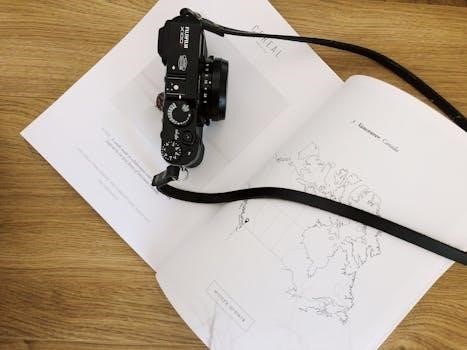
Overview of Romeo and Juliet
This comprehensive study guide delves into Shakespeare’s iconic tragedy, offering insights into its timeless themes and complex characters. It provides resources for understanding the play’s historical context, plot, and language, aiding students in analysis.
Romeo and Juliet, penned by William Shakespeare in the late 16th century, stands as a quintessential romantic tragedy, exploring themes of love, hate, and fate. The play is set in Verona, Italy, and revolves around two young lovers from feuding families, the Montagues and the Capulets. This dramatic work has captivated audiences for centuries with its passionate language, complex characters, and a plot that ultimately culminates in tragedy. Through poetic dialogue and heart-wrenching scenes, Shakespeare masterfully portrays the intensity of young love and the devastating consequences of societal conflict. It’s a cornerstone of English literature and a play that continues to resonate today.

Key Characters and Relationships
The play features a cast of memorable characters, from the passionate Romeo and Juliet to their feuding families, the Montagues and Capulets. Their relationships drive the plot.
The Montagues and Capulets Feud
The central conflict of the play stems from the long-standing feud between the Montague and Capulet families. This bitter rivalry, the origin of which is never fully explained, permeates the entire society of Verona, creating an atmosphere of tension and violence. The feud’s impact extends beyond the immediate families, affecting the lives of many other characters in the play, such as Mercutio and Tybalt. This hatred is a major catalyst for the tragic events that unfold, as it creates an impossible environment for Romeo and Juliet’s love to flourish. The senseless conflict highlights the destructive nature of hate and the consequences of societal division.
Romeo and Juliet’s Love Story
At the heart of the play is the passionate and intense love shared by Romeo and Juliet. Their relationship is characterized by a whirlwind romance, marked by their instant connection and declarations of devotion. This love, however, is forbidden due to the animosity between their families. Their desperate attempts to defy this barrier lead them to a secret marriage and ultimately contribute to their tragic demise. Their relationship is a powerful symbol of the conflict between personal desires and societal constraints. The speed and depth of their feelings highlight the intensity of young love. Their story has become a timeless representation of romance and tragedy.

Act-by-Act Analysis
This section provides a detailed breakdown of each act in Shakespeare’s play, examining key plot points, character development, and the progression of the tragic narrative. Understanding each act helps to interpret the overall story.
Act I⁚ Setting the Stage
Act I introduces the city of Verona and the long-standing feud between the Montagues and Capulets, quickly establishing a tense atmosphere. The audience is immediately made aware of the conflict when a brawl erupts between servants from the two households. Prince Escalus threatens severe punishment if any more fighting occurs, but this is not enough to resolve the hostility. We are introduced to Romeo, initially lovesick for Rosaline, before he meets Juliet. This act lays the foundation for the central conflict and the tragic events to follow. The famous prologue describes the lovers as ‘star-cross’d,’ foreshadowing their doomed fate. We also begin to see the distinct personalities of key characters such as Tybalt, the aggressive Capulet.
Act II⁚ The Development of Love
Act II centers on the blossoming love between Romeo and Juliet despite the intense familial hatred that surrounds them. Following their first encounter, Romeo, with the help of Mercutio and Benvolio, sneaks into the Capulet orchard where he shares a secret balcony scene with Juliet. Their declarations of love lead to a private marriage ceremony, arranged by Friar Laurence. This act is characterized by secrecy, hope, and heightened emotion, in stark contrast to the violent conflict of Act I. The lovers’ passion is depicted through beautiful, poetic language, and the act focuses on the intensity and immediacy of their feelings. This part of the play showcases the naivety and impulsiveness of young love.
Act III⁚ Rising Action and Conflict
Act III of Romeo and Juliet marks a turning point where the rising action rapidly escalates. A street brawl between the Capulets and Montagues leads to the tragic death of Mercutio at the hands of Tybalt. Enraged, Romeo kills Tybalt, leading to his banishment from Verona by the Prince. Juliet is devastated by the news of Romeo’s banishment and Tybalt’s death. This act is characterized by a swift shift from love to despair, and the characters grapple with the consequences of violence. The act highlights the destructive nature of the feud and the increasing desperation of the young lovers. The conflict intensifies, setting the stage for the play’s tragic conclusion.

Themes and Literary Devices
Explore the play’s profound themes, such as love, fate, and conflict, and Shakespeare’s masterful use of language. This section examines figurative language, like metaphors, and allusions, enhancing understanding.
Themes of Love, Hate, and Fate
The play explores the intense and passionate love between Romeo and Juliet, which blossoms amidst a backdrop of deep-seated family hatred. This conflict between love and hate is a central theme, highlighting the destructive nature of feuds. Fate, or destiny, also plays a crucial role, as the lovers are described as “star-crossed,” suggesting their tragic end is predetermined. The play questions whether their destiny is entirely decided by fate or if their own choices contribute to their downfall. This interplay of forces creates a powerful narrative of love, conflict, and the inevitability of tragedy.
Shakespeare’s Use of Language
Shakespeare’s mastery of language is evident in “Romeo and Juliet,” where he employs a rich tapestry of poetic devices. The play showcases his use of iambic pentameter, creating a rhythm that enhances the emotional intensity. Characters often speak in verse, filled with metaphors, similes, and allusions, enriching the dialogue with layers of meaning. The use of puns and wordplay adds a playful dimension, particularly in the conversations between Mercutio and Romeo. The contrast between formal and informal language reflects the social hierarchy and the characters’ relationships, adding depth and complexity to the narrative. This linguistic artistry contributes to the play’s enduring power and beauty.
Figurative Language in the Play
Shakespeare’s “Romeo and Juliet” is replete with figurative language, enhancing its dramatic impact and emotional depth. Metaphors like “Juliet is the sun” elevate the romantic intensity, portraying love as a powerful, radiant force. Similes, such as comparing Romeo’s love to a “tempest,” reveal the tumultuous nature of their passion. Allusions to mythology and classical figures add layers of meaning, connecting the characters’ experiences to universal themes. Hyperbole, with exaggerated statements like “a thousand times good night,” underscores the characters’ heightened emotions. These literary devices enrich the text, making it engaging and thought-provoking, while also revealing deeper insights into the play’s themes of love, fate, and conflict.

Study Guide and Resources
This section provides essential tools for students, including vocabulary, key terms, and study questions. It aids in deeper understanding and test preparation, facilitating effective learning of the play.
Vocabulary and Key Terms
Understanding Shakespeare’s language is crucial to appreciating Romeo and Juliet. Key terms like “adversary,” “boisterous,” and “nuptial” appear throughout the play, each carrying significant weight. These words, often unfamiliar to modern readers, require careful consideration to grasp their nuances within the context of the story. Exploring words like “allusion,” “hyperbole,” and “metaphor” reveals Shakespeare’s use of figurative language. Additionally, familiarize yourself with terms related to the social and cultural setting, such as “feud” and “star-crossed,” to fully comprehend the play’s themes. This vocabulary list will help students dissect Shakespeare’s language more effectively.
Study Questions by Act and Scene
This section offers a structured approach to analyzing Romeo and Juliet, providing specific questions for each act and scene. Beginning with Act I, examine the escalating conflict between the Montagues and Capulets, and the introduction of key characters. In Act II, consider the development of Romeo and Juliet’s love story, and the challenges it faces. Act III’s questions will focus on the rising action and tragic turning points, such as Mercutio’s death. These questions encourage close reading, prompting thoughtful responses about character motivations, plot developments, and thematic elements. This detailed breakdown allows for a thorough understanding of the play’s structure and progression.
Test and Quiz Preparation
This section is designed to support your preparation for assessments on Romeo and Juliet. It includes a variety of practice questions, covering key plot points, character analysis, and thematic understanding. You will find multiple-choice questions that test your knowledge of specific events and relationships, as well as short-answer questions that require deeper analysis. Additionally, be prepared to encounter essay-style prompts that will require you to synthesize your understanding of the play’s major themes. We also will cover questions on Shakespeare’s use of language and literary devices. This section aims to provide comprehensive practice, ensuring you are ready for any type of assessment.
Additional Resources
Explore further with film adaptations, online study aids, and various interpretations of Romeo and Juliet. These resources offer diverse perspectives and deepen your understanding of the play.
Film Adaptations and Interpretations
Numerous film adaptations of Romeo and Juliet offer unique interpretations of Shakespeare’s classic tragedy. Baz Luhrmann’s 1996 version, for example, sets the story in a modern, stylized world, contrasting sharply with Franco Zeffirelli’s more traditional 1968 adaptation. These films explore the play’s themes through different lenses, highlighting elements such as the intense passion between Romeo and Juliet and the destructive nature of the family feud. They also showcase the timeless quality of the story, demonstrating its continued relevance across various settings and cultures. Exploring these adaptations can provide valuable insights into the play’s themes and characters. Furthermore, various theatrical performances offer additional interpretations, showcasing the text’s adaptability to diverse artistic visions.
Online Study Aids and Guides
Numerous online resources offer assistance for studying Romeo and Juliet, providing a variety of tools to enhance comprehension. Websites like SparkNotes and Course Hero provide summaries, character analyses, and explanations of key themes, which can be very helpful. These platforms often include quizzes, test preparation materials, and vocabulary lists, offering comprehensive support for student learning. Some resources also provide act-by-act breakdowns, character maps, and in-depth analysis of Shakespeare’s language. Interactive elements like flashcards and online forums can facilitate active engagement with the text, making it easier to grasp complex concepts. Utilizing these aids can provide a well-rounded understanding of the play. Moreover, many educational institutions offer their own study guides online.

